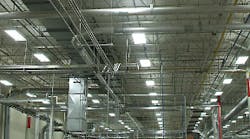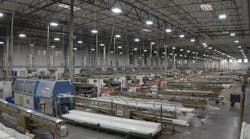Despite the industrial sector’s growing attention to energy efficiency, electrical contractors and facility managers often face challenges when convincing management that it’s time for a lighting upgrade. With a basic understanding of the facility’s operational needs and existing energy usage, facility managers and contractors can propose more efficient lighting solutions that can save their companies energy, labor, and maintenance costs. But as with any investment, executives will want to know the bottom-line benefits of a new project. Fortunately, the lighting sector already has an array of tools that help calculate energy savings, tax incentives, and utility rebates.
Beyond energy savings
While lower electric bills are an obvious gain, efficient lighting systems also create tangible workplace benefits, such as improved morale, increased production, and fewer mistakes. In fact, a study by the Rocky Mountain Institute, “Greening the Building and the Bottom Line,” by Joseph J. Romm and William D. Browning, December 1998, found that a 1% productivity increase could generate enough savings to exceed a company’s entire energy bill. The businesses in the study saw measurable increases in worker productivity, lower absenteeism, and fewer errors/manufacturing defects after making efficiency improvements to their lighting and climate systems.
Aside from performance benefits, upgrades make sense from a basic safety perspective as well. The many moving parts typical of an industrial environment can present hazards to employees and interfere with quality, efficient production. For example, older lighting systems may take time to reach full brightness in the event of a power loss. If the machinery starts moving as soon as the power returns, employees may be working in an environment without proper lighting. By replacing aging systems with energy-efficient, fluorescent lighting with instant startup capabilities, businesses can reduce the risk of accidents while realizing up to a 50% decrease in wattage.
Compact fluorescent, as well as high-efficiency T8 and T5 linear fluorescent lamps, are among the top choices for providing adequate light in industrial environments, particularly when paired with energy-efficient ballasts.
Decreasing maintenance cost
When investing in an upgrade, it’s wise to consider future maintenance costs for the lighting system. Evolving standards and regulations will impact costs, and by keeping current with changes, contractors and facility managers can make smarter decisions. In addition, future maintenance costs are often lower for higher-efficiency lighting solutions. Aside from longer life and fewer replacements, these products help prepare the facility for meeting new standards — such preparation adds convincing value to your lighting proposition.
For example, the Energy Independence and Security Act (EISA) of 2007 mandates that 105W to 500W metal-halide ballasts manufactured after January 2009 must include efficiency improvements, as described in Table 1 (click here to see Table 1). In addition, these ballasts and luminaire cartons must include a “Circle E” label, as prescribed by the U.S. Federal Trade Commission. Similarly, mercury vapor ballasts have been out of production since 2008, making it difficult to secure replacements and spares. While facility managers can continue to buy replacement parts until current inventories are depleted, the law of supply and demand dictates that prices for these parts will be at a premium, resulting in higher maintenance costs.
When considering maintenance costs, new technologies and components, such as electronic ballasts, generally have longer life expectancies and good warranties. Long-life and LED lamps are other energy- and maintenance-friendly alternatives, while power-factor-correcting devices and occupancy and ambient sensors help extend system life while decreasing energy consumption.
Sweetening the upgrade proposal
Data from energy savings, workplace improvements, and decreased maintenance costs can build an impressive case for making the upgrade, especially when combined with a simple “cost of waiting” calculation, which emphasizes the immediate energy savings. When comparing existing system costs to the costs of the proposed system, it’s important for contractors and facility managers to include kWh load versus proposed kWh load data, HVAC savings benefits, and any decrease in hours of operation due to daylighting and harvesting. Contractors should also include a current-maintenance versus future-maintenance cost comparison in their proposal as well as savings from federal tax and energy rebates. Your supplier may also be able to provide leasing support and/or project financing, structuring the programs to show a monthly positive cash flow.
Fixtures and controls
Aside from energy-efficient products, energy savings can be realized by working with the light existing in the natural environment. To benefit from this approach, contractors should examine ambient lighting levels as well as how lighting and climate controls are currently being used. Many product solutions can also be combined with pre-existing infrastructure to generate added savings. Table 2 (click here to see Table 2) offers additional questions contractors and facility managers should ask when approaching an upgrade.
An efficient lighting system will take a two-pronged approach, integrating new lighting fixtures with traditional controls. According to the New Buildings Institute, a nonprofit organization working to improve the energy performance of commercial buildings, controls can reduce lighting energy consumption by as much as 50% in existing buildings. These controls help facilities manage their energy levels by ensuring electricity is only used for lighting when necessary.
For example, in a basic HID lighting system, lamps turn on at full power but can take up to 15 min. to reach full brightness. Once the appropriate lighting level is reached, they no longer need full power. A control can help the system decrease this electrical current, thereby reducing energy usage.
Typical control technologies include time switches, panels, daylight-harvesting sensors, and dimming ballasts. Depending on the application and the facility’s needs, controls can be a part of complex existing automation structures, or they can be as simple as a traditional time clock that alters the lighting levels based on an established schedule.
When considering controls, contractors and facility managers should look at state and local codes as well as existing technologies that can be integrated with the new system. They should also determine whether the controls will be automatic or scheduled — and how the cost affects the return on investment.
Preparing for the future
Although simple lighting upgrades can assist industrial facilities in reducing operating costs and energy consumption, many facilities continue to employ older technologies that will result in higher maintenance costs in the near future. By not upgrading, these businesses are also missing out on potential productivity and safety gains. Contractors and facility managers who can demonstrate real returns on investment will realize new opportunities in lighting, if approached correctly.
Pilgrim is manager of Lighting Business Development for Graybar’s Dallas District and a former president of the Illuminating Engineering Society of North America’s North Texas Section.




